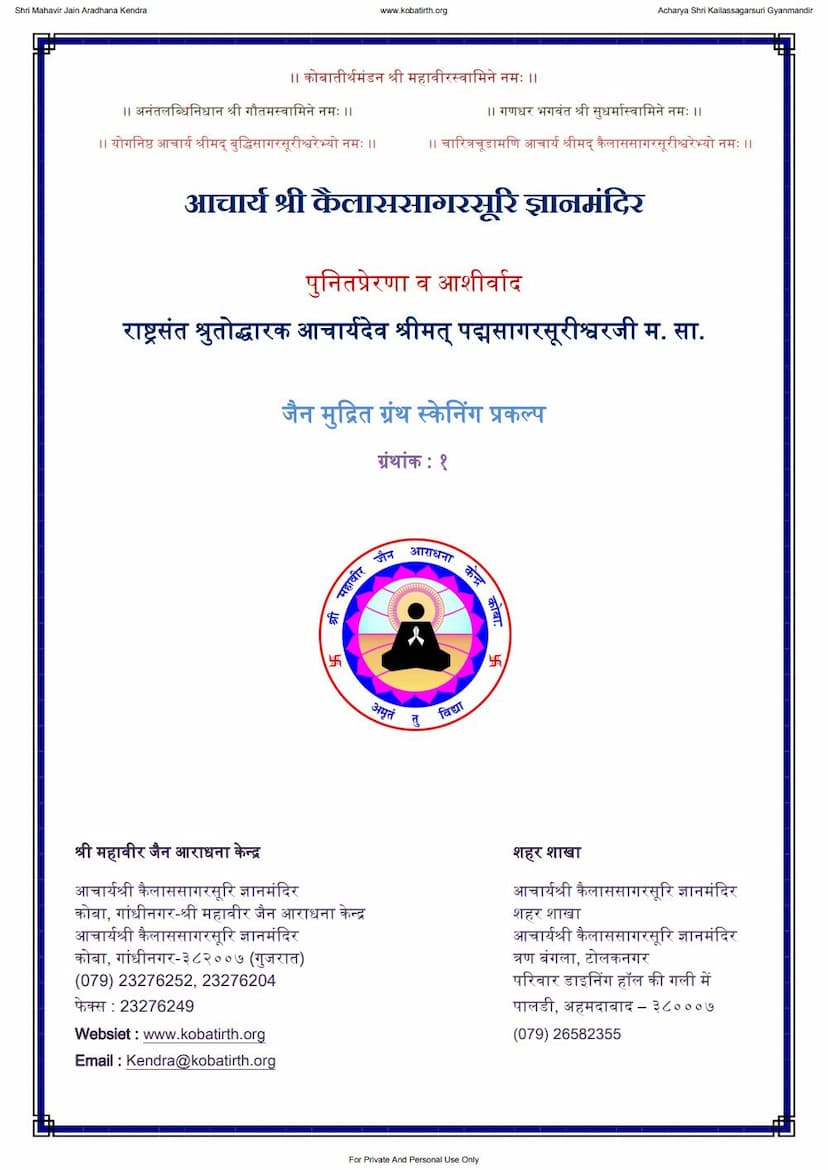Valmiki Ramayanam Part 01
Added to library: September 2, 2025

Summary
This Jain text, "Valmiki Ramayanam Part 01," published by Amar Publication, is a comprehensive commentary on the epic Ramayana, specifically the Balakanda. The provided text appears to be an excerpt from this larger work, focusing on the initial chapters and offering detailed explanations and interpretations.
Here'I's a breakdown of the key aspects of the text:
1. Publisher and Origin:
- The text is published by "Amar Publication" and is attributed to "Amar Publication" as the author.
- It is part of the "Shri Mahavir Jain Aradhana Kendra" and associated with "Acharya Shri Kailassagarsuri Gyanmandir" in Koba, Gujarat, indicating a Jain religious and educational context.
- The catalog link suggests it is part of a larger Jain digital library project.
- A disclaimer "For Private And Personal Use Only" is prominently displayed.
2. Nature of the Text:
- This is not the original Valmiki Ramayana itself but a detailed commentary on it.
- The title mentions specific commentaries like "Govinda Rajiya," "Ramanujiya," "Tanishloki," and "Maheshwar Tirtha," indicating that this work synthesizes multiple scholarly interpretations.
- It also includes "Munimavaprakasika Satyatirthi Adi Vyakhyot Tippani Samvalitam," suggesting extensive annotations and discussions.
3. Content Focus (Balakanda): The provided pages are heavily focused on the Balakanda (the childhood or formative years of Rama). The text includes: * Introduction to Ramayana: Pages 7-15 provide an extensive introduction to the Ramayana, discussing its significance as an "Adi Kavya" (first epic poem), its inspiration from Valmiki's pathos, its influence on later literature (like Kalidasa's Raghuvamsa), its ethical and cultural importance, and its detailed structural division into seven Kandas. * Detailed Chapter Summaries (Anukramanika): Pages 30-75 offer a chapter-by-chapter synopsis of the Balakanda, Ayodhyakanda, Aranyakanda, and Kishkindhakanda, outlining the key events and narratives within each. This is a crucial part of understanding the structure and flow of the epic as presented in this commentary. * Commentary on Verses (Tika/Vyakhyana): The bulk of the text (pages 76 onwards) consists of detailed verse-by-verse or section-by-section commentary. This commentary explains the meaning of the verses, delves into philosophical and linguistic nuances, and references other scriptures (like Puranas, Vedas). * Specific Episodes: The commentary appears to detail significant episodes within the Balakanda, such as: * The creation of the universe and the lineage of kings. * The divine intervention of Vishnu to address the imbalance caused by Ravana. * The story of Valmiki's inspiration and the origin of the Ramayana itself (Shloka 1 starting with "Ma nishada..."). * The birth of Rama and his brothers, their upbringing, and education. * Rama's training, the blessings he received, and his exceptional qualities. * The mission to protect Vishwamitra's sacrifice, the slaying of demons like Tataka and Subahu. * The encounter with Sage Vishwamitra, his guidance, and the bestowing of divine weapons. * The lineage of Vishwamitra and the story of his ancestors. * The story of the river Ganga's descent, its origins, and its connection to Bhagiratha and Sagara. * The description of Ayodhya and its prosperity. * The ethical and social aspects of the era depicted in the Ramayana. * The philosophical and spiritual underpinnings of the epic. * Jain Context: While the text is about the Ramayana (a primarily Hindu epic), its presentation under the "Shri Mahavir Jain Aradhana Kendra" and the invocation of Jain deities (Shri Mahavir Swami, Shri Gautam Swami, Shri Sudharma Swami, Acharya Kailas sagarsuri) suggests that this commentary might offer a Jain perspective or interpretation of the Ramayana, or it's part of a collection where diverse texts are preserved. However, the commentary itself, as presented in these pages, focuses on the traditional narrative of the Ramayana.
4. Key Themes Highlighted in the Introduction:
- Indian Culture: The Ramayana is presented as a cornerstone of Indian culture.
- Adi Kavya: It is recognized as the first epic, composed by the "Adi Kavi" Valmiki.
- Pathos (Karuna Rasa): The composition was inspired by the poet's feeling of pathos.
- Influence on Literature: Valmiki's work served as a model for subsequent poets.
- Ethical Value: The ethics of the Ramayana are considered universally applicable and exemplary.
- Dharma: The central motive is the Indian concept of Dharma, the struggle between truth and darkness.
- Geographical and Cultural Unity: The Ramayana reflects India's geographical and cultural unity.
- Rama as an Ideal: Rama is presented as the ideal man, embodying divine grace and human ethical height.
- Ramarajya: The concept of an ideal reign characterized by peace, prosperity, and absence of suffering is highlighted.
- Historical Insight: The epic provides historical and political insights into ancient Indian civilization.
- Popularity and Translations: The Ramayana's widespread popularity, its translation into various Indian and other languages, and its influence across Southeast Asia are noted.
- Authorship and Textual Variations: Valmiki's authorship is affirmed, and the existence of four major recensions of the text is mentioned.
- Commentaries: The text lists and discusses several important commentaries on the Ramayana, with a particular focus on the four included in the present edition.
In Summary:
This Jain commentary on the Balakanda of the Valmiki Ramayana, published by Amar Publication and linked to the Jain Aradhana Kendra, provides a scholarly and detailed exposition of the epic's initial part. It emphasizes the Ramayana's cultural, ethical, and philosophical significance, drawing upon various ancient commentaries to explain Valmiki's verses and the deeper meanings within the narrative. The commentary highlights the ideal qualities of Rama, the importance of Dharma, and the rich cultural tapestry of ancient India as depicted in the epic.